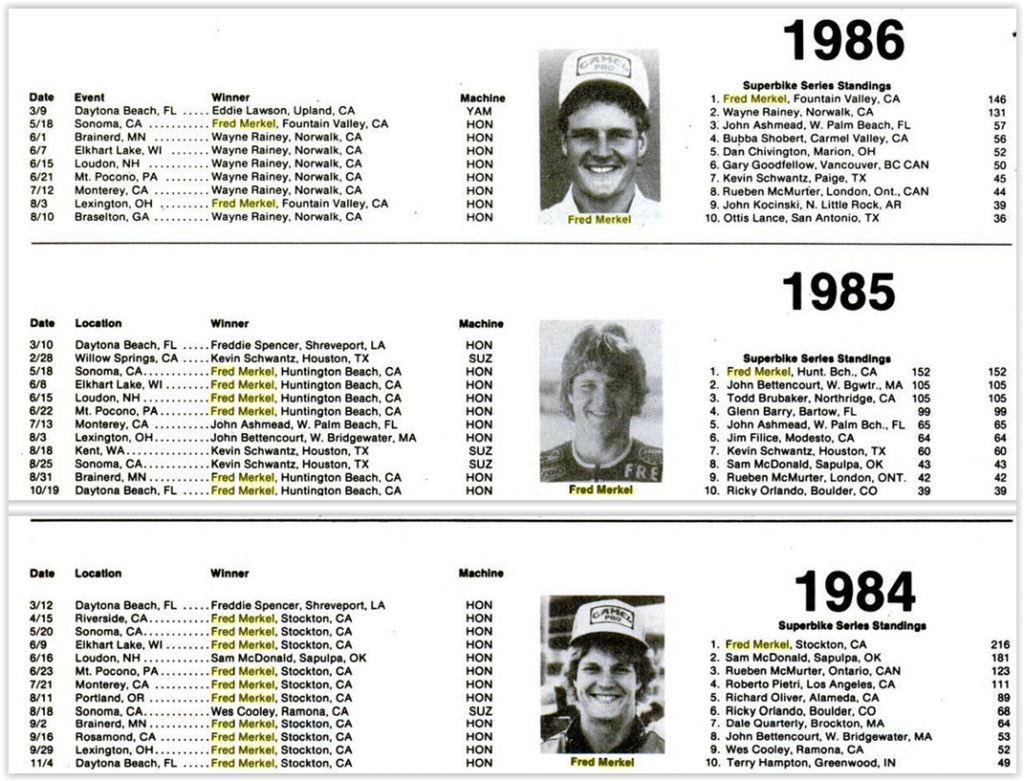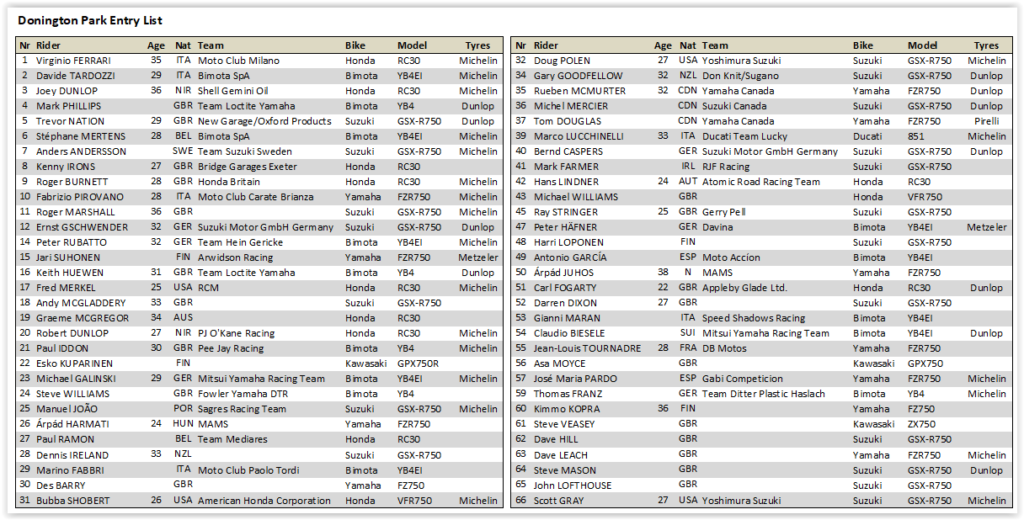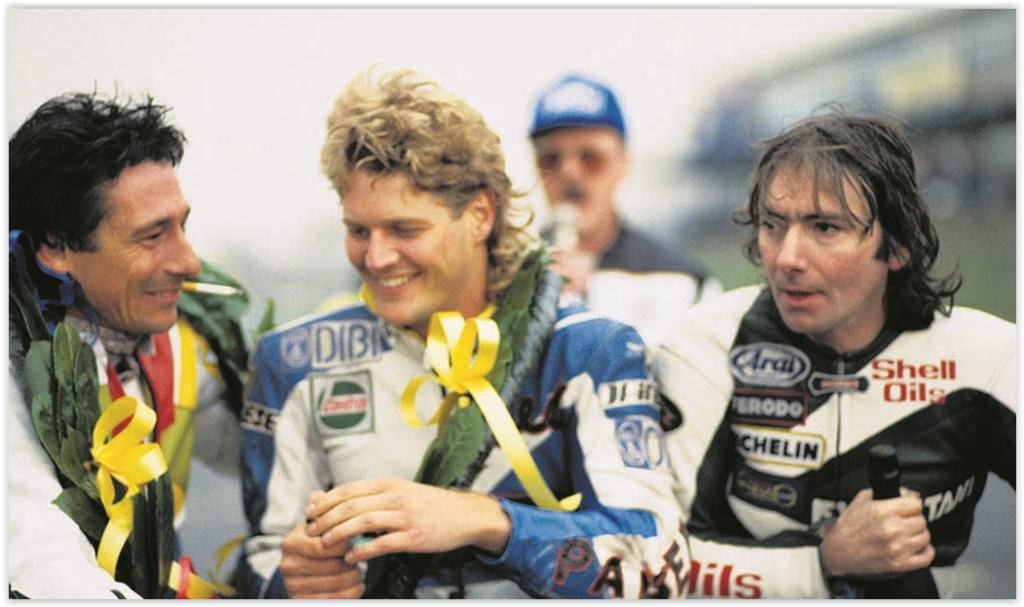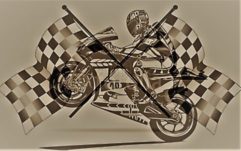
Rumi Honda – a perfect example for today’s factory teams
What is completely normal for Japanese motorcycle manufacturers in MotoGP and WorldSBK today was rather untypical in the year the Superbike World Championship was born. After Suzuki had established a new type of thoroughbred sports motorcycle with the legendary GSX-R750, the world’s largest manufacturer was determined to follow suit. That is why they created the VFR-750R RC30 in 1987 in order not to make life too easy for the competitor from Hamamatsu. The first bike from Honda, which was created directly for use on the racetrack and was freely available. What almost all manufacturers are doing today to raise prices to a level that sometimes seems almost outrageous was still rather untypical at the time. They decided on a small series limited to 5000 pieces, with the proud price of around 28,000 D-Marks in Germany (9.622 GBP). A lot of wood to be just a tad better than Suzuki and its icon.

The clear goal for the development of the RC30
Of course, Honda had a clear goal with the development of their RC30. It was about taking part in the newly launched Superbike World Championship with this bike the following year. Ducati had a cubic capacity advantage over the Japanese due to the regulations, and that is why Honda wanted to nail it down. Two years later, Yamaha was to follow up with the OW01 FZR750R and thus be absolutely on par with its competitors, while Suzuki for many surprisingly decided not to participate in the factory. Honda, on the other hand, chose a European partner for their commitment and provided a driver who was one of the absolute best on the scene in the USA. Superbike races have enjoyed a high level of attention there for many years, while in Europe the final breakthrough for races on near-series bikes was only to come with the help of the near-series SBK World Championship planned for the 1988 season.

The Honda partner for the Mission World Championship
Rumi is, as many people don’t even know anymore, actually a historical motorcycle brand from Italy. Founded four years after the Second World War as Moto Rumi, the company later became Officine Fonderie Rumi, based in Bergamo (Northern Italy). Originally, Donnino Rumi’s factory manufactured machines for the textile industry. Only later did they begin to produce two-stroke models with a horizontal 125 cm³ parallel twin, which had been developed by Pietro Vassena. Larger models and scooters were added later, as well as motorcycles with V-2 engines with hanging valves from 1960 onwards. A little later, engine production was completely stopped, but GoKart engines were still built until 1966. In the 1970s the name Rumi came back and road racing machines were manufactured with 125 cc engines and became a partner of the Honda factory team for entry into the superbike class.

The hair-raising regulations – a real miscarriage
The later Ducati WSBK team principal and manager in MotoGP, Davide Tardozzi, was one of the first victims of a truly hair-raising regulation. As a race winner at the premiere in Donington Park (England) on March 27, 1989, he had bad luck on his Bimota YB4EI in the second race, which meant that he had to travel from England to Hungary without any World Championship points. A blatant example of what kind of sick brains were partly responsible for such nonsense in motorsport authorities and some still are today, or have found equivalent successors. The unfortunate Italian rode a bike with the engine of the legendary Yamaha FZ-750 and Italian chassis, which was a kind of hybrid and was still considered a separate brand. Actually, a great starting point for Kawasaki should they want to return to MotoGP anytime soon. The best thing to do is to add a Suzuki, Yamaha or Honda engine and your own chassis, and you will be successful straight away.

First WSBK podium for the Rumi Honda driver and the successful continuation
The Honda team based in Italy could hardly have started the new championship better than in Donington. Together with Marco Lucchinelli and Joey Dunlop, Fred Merkel beamed on the lap of honor after the two races. The stupid regulations were corrected for the second event of the SBK World Championship and from the Hungaroring onwards there were points per run, but at that time only 10 points were awarded for the winner instead of the 25th today should be the case in the second year per race. After a fourth and second place, he traveled on to Budapest in second overall, where he won the first run and was seventh in the second. At Hockenheim, he remained without points after P17 in the first run and a retirement on the penultimate lap. In the first run in Spielberg (Austria), the Californian did not see the checkered flag after a crash in the first round.

The key to the first success was constancy
After two failures, an impressive series followed for Merkel and his RCM Oscar Rumi team. From the second run on today’s Red Bull Ring, the US boy scored points every time. The first race at the season finale was only his second win of the season, but it was also perhaps the most important of his life. Only unlucky Tardozzi and his also extremely constant Italian compatriot Fabrizio Pirovano still had a chance, albeit a slim one, of preventing the man from the country of origin of the Superbike races from winning the title before the last race in Mansfeild (New Zealand). But he did everything right together with his team from northern Italy and drove a safe fifth place home, while Stéphane Mertens won and the two Italians failed. Pirovano had only crossed the finish line in P13, and Tardozzi was eliminated with a crash. The latter, together with the Bimota guys, was likely to have been annoyed for a long time about the 10 points “stolen” by the FIM in Donington. With four wins and those missing ten points, it would have been enough for him for the title.

The continuation of a success story
For the 1989 season, Rumi Honda entered with an additional second driver who came from their own country. A very promising man had been found in the person of Piergiorgio Bontempi from the port city of Ancona, who was rather sturdy for a racing driver. He had previously competed in the 125 cm³ class, for which he was, however, severely disadvantaged with his stature compared to many of his competitors. Initially, however, he had a hard time in the SBK and failed miserably in the first few laps. Only in Enna-Pergusa, the only event in WorldSBK history, did he score points in both races. Merkel even drove three races in the 500 cm³ motorcycle world championship for Honda this year. The best result in Donington Park was 11th place. Things went much better for the Californian when he defended his title, as our graphic below shows.


The difficult third year for Rumi Honda
After two World Cup titles, it was, as expected, difficult to be at the top again at the end of the 1990 season. Ducati in particular was extremely strong with former Grand Prix driver Raymond Roche, and Yamaha was also very well positioned with Fabrizio Pirovano. Then there are the fast people like the intrepid Giancarlo Falappa (Ducati), called “Lion of Jesi” by the fans, as well as the Belgian Stéphane Mertens (Honda), the two Englishmen Rob McElnea and Terry Rymer (both Yamaha). Kawasaki also got involved in the factory with the Australian Rob Phillis, and with Baldassare Monti Fred Merkel got a much stronger teammate. The season started this time in Jerez de la Frontera and for the first time in the history of the Superbike World Championship on Spanish soil. Merkel finished second behind Roche in the first race, and in the second he was third behind the Frenchman and his teammate Falappa. This was followed by three wins for the American in the following six races and 3 laps, and only on the Hungaroring did he miss the podium with a 6th place in the second race.

The problems from Mosport and the lost title fight through an injury
The world’s elite were to be guests for the last time on the scandalously dangerous route in Canada. While World Cup leader Roche extended his lead with a double victory, Merkel had to be content with ranks 5 and 10. In his homeland, of all places, things didn’t go according to plan at all. Tire difficulties prevented a better result at the event in Brainerd, after which things started to improve again in Spielberg, Austria. But then came the end for the next two rounds. American Motorcyclist magazine named the reason for this in an article. Because Merkel, a frequent starter, should also hold up for Honda in the famous Suzuka 8-hour race, he traveled to Japan at the end of July. As a winner in 1984 together with Mike Baldwin, however, 6 years later he had no luck. Already during training he was seriously injured in a fall and was therefore out of the next two SBK laps. Despite Roche’s victory in the drivers’ world championship for Ducati, Honda at least won the brand classification. Stéphane Mertens in third place in the World Cup and Baldassare Monti in 8th place contributed significantly to this. There was no team classification at the time, but with a total of 346 points, Rumi would hardly have been able to achieve first place compared to Team Loctite Yamaha with 376.

The years after the lost title
With Fred Merkel and Baldassare Monti, Rumi Honda started its fourth season in 1991 with the same line-up and thus the fourth year of the near-series World Championship. Before the first race, nobody could have guessed that Merkel’s compatriot would be the outstanding figure. As a private driver for the US Fast by Ferracci team, Doug Poland was an absolute sensation. The Ducati driver from Detroit, Michigan, won the first race in Donington Park straight away. With an engine failure, he retired in the second race and then won the next four races in a row. This, except for the scandalous race in Mosport (Canada), which was boycotted by the stars fighting for the World Cup due to the dangerous nature of the route.

The unbelievable series from Poland and a Rumi Honda team without a chance
After finishing second in Spielberg (Styria / Austria), the US boy was on top of the podium seven times without a break. Only a certain Jonathan Rea (Kawasaki ZX-10RR) would equalize his streak of 17 victories in one season almost two decades later. For Merkel, on the other hand, the season practically only began on lap four of his home race. In Donington Park he retired in both races with engine problems and in Jarama (Spain) afterwards with a crash in both races. The Californian had to risk a lot more to at least try to keep up with the best. On the aging VFR-750 RC30, however, this was almost impossible. In principle, therefore, he was as good as without a chance to be at the forefront as in the past.

Also the second driver with a lot of bad luck
Teammate Monti felt the same and saw the checkered flag in the first 4 races only once in 6th place due to an engine failure and two falls. After two top ten results in Brainerd (USA), he did not participate in the races after an injury in Spielberg and was only seen one last time in Mugello. However, he did not start there and that meant the season was over for him. At the side of the unknown Richard Arnaiz from the USA, the Italian competed again for Rumi Honda the following year. This could not even qualify for the race in Albacete at the season opener. Monti was only there until Japan, and a sixth place on the track in Spain should remain his best result. With position 17 in the World Cup for the Italian and his team, there was of course no state to be made. A new weapon from Honda in the fight for the World Cup was also not in sight. It was therefore not surprising that the Italian team was no longer represented in the paddock for many years from 1993 onwards.

Promotion of young talent and a short comeback
Rumi was also involved in the 600 Supersport Championship with Rubén Xaus, who was sixteen at the time, and was on hand when the Superstock class was also introduced in this class. In the 2002 season, the Rumi team entered the SBK World Championship again and competed with the Englishman Mark Hackles as Honda Castrol’s satellite American on the VTR-1000 SP2. After a disappointing season and sponsorship problems, however, the exit came immediately afterwards. From then on, the company made its experience available, particularly in national racing. Rumi no longer appeared internationally, but this name, like that of Alstare, Ten Kate, Puccetti and many others, will remain indelibly linked to the history of the Superbike World Championship.

Rumi Honda’s successes in the WSBK

The successes of the Rumi team and their role model effect
Before joining the SBK as a Honda works team, Rumi had already won the Italian SBK championship in 1987. In the 1990 season they won the SBK European Championship and in 1991 again the one at home. The example of the liaison between Honda and the Italian team should certainly set a precedent. A little over 40 years later, both the MotoGP team of the world’s largest manufacturer and that of HRC for WorldSBK were both domiciled in Spain. The one from Kawasaki is also in the immediate vicinity. Yamaha also has its European base, the brand with the crossed tuning forks in the logo has been operating from northern Italy for both World Cup series for years.

You can find more about all years of the WorldSBK in our richly illustrated history.
Unless otherwise mentioned, applies to all images (© WorldSBK).

No Comments Yet